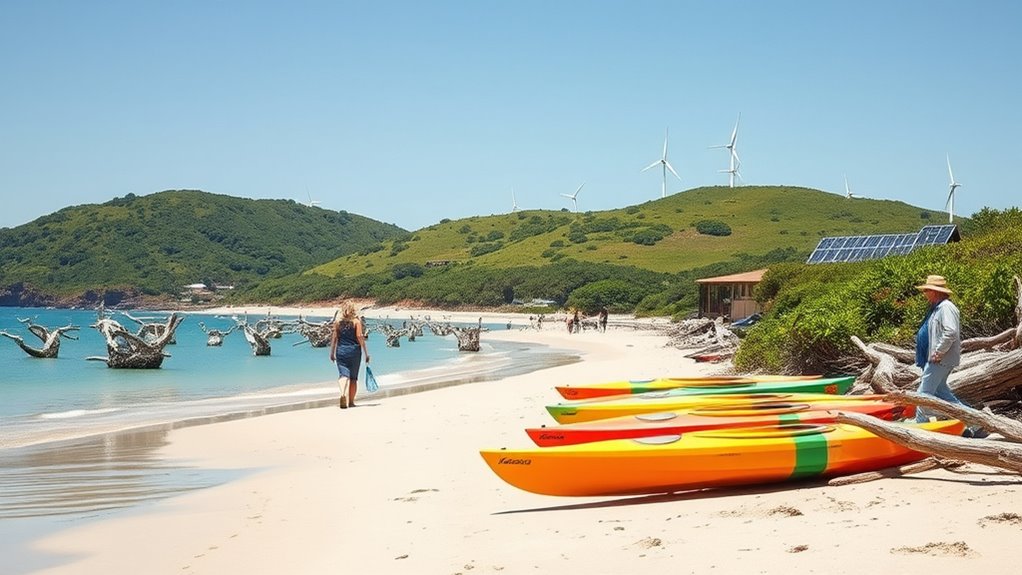To travel sustainably and combat climate change, choose eco-friendly accommodations, support local communities, and opt for greener transportation like public transit, biking, or electric rentals. Plan trips to minimize travel days, take direct flights, and travel during off-peak times. Don’t forget to offset your carbon emissions through reforestation or renewable projects. Small mindful choices can make a big impact; explore more tips to help you travel greener every step of the way.
Key Takeaways
- Choose eco-friendly accommodations that prioritize renewable energy, water conservation, and support local communities.
- Minimize travel emissions by using public transportation, biking, walking, or selecting electric rental vehicles.
- Offset your travel-related carbon footprint through reforestation and renewable energy programs.
- Plan trips efficiently by combining destinations, traveling off-peak, and opting for direct flights.
- Support local sustainability initiatives and buy locally produced goods to preserve natural and cultural resources.

Travel considerably contributes to climate change, as the transportation sector is a major source of greenhouse gas emissions. Every time you hop on a plane, cruise, or drive a car, you’re adding to the carbon footprint associated with your trip. But there are ways to enjoy your travels while minimizing your environmental impact. One effective approach is choosing eco-friendly accommodations. These places often run on renewable energy, implement water and waste conservation measures, and support local communities. By staying in green hotels or eco-lodges, you not only reduce your carbon footprint but also promote sustainable tourism practices. Many eco accommodations are certified by reputable organizations, so you can easily identify places committed to environmental responsibility. Additionally, you can look for accommodations that participate in carbon offset programs. These programs allow you to compensate for the emissions generated during your stay by investing in projects like reforestation, renewable energy, or community development. When you book a stay that supports carbon offset initiatives, you’re directly helping to balance out the emissions from your travel, making your trip more sustainable overall.
Choosing eco-friendly accommodations and supporting carbon offset programs helps make travel more sustainable and environmentally responsible.
Beyond the choice of accommodations, you should also consider how you get around once you arrive. Opt for public transportation, biking, or walking whenever possible. These modes of travel reduce emissions compared to taxis or rental cars. If you need to rent a vehicle, choose fuel-efficient or electric options. This way, you’re actively decreasing your carbon footprint during your trip. Being mindful of your transportation choices is vital because travel emissions can quickly add up, especially on long journeys. Incorporating sustainable transportation options can significantly lessen your environmental impact.
You can also make a bigger impact by planning your trips thoughtfully. Combine multiple destinations into one trip to reduce total travel days and emissions. Traveling during off-peak seasons can lessen the strain on transportation and accommodation resources, and choosing direct flights over layovers helps cut down on emissions caused by takeoffs and landings. Remember, small changes in your travel habits can collectively make a significant difference.
Finally, educate yourself about local sustainability initiatives and support them. Whether it’s participating in community-led conservation programs or buying locally produced goods, your actions can help maintain the natural beauty and cultural integrity of your destinations. By making conscious choices around accommodations, transportation, and activities, you guarantee your travel contributes less to climate change and more to the preservation of the places you visit. With awareness and deliberate planning, you can enjoy enriching travel experiences while helping protect the environment for future generations.
Frequently Asked Questions
How Can Travelers Support Local Conservation Efforts Effectively?
You can support local conservation efforts by engaging in community involvement and responsible volunteering. Participate in local projects that promote environmental protection and respect local customs. Always research and select reputable organizations that prioritize sustainability. Your efforts help preserve ecosystems and support local communities. Remember, responsible volunteering means contributing meaningfully without causing harm. By actively supporting these initiatives, you make a positive impact on conservation and ensure your travel benefits both the environment and locals.
What Are Innovative Eco-Friendly Transportation Options for Travelers?
You might worry eco-friendly options won’t be practical, but they can be both fun and efficient. Consider renting an electric vehicle for longer trips—it’s quiet, clean, and reduces emissions. For city exploring, try bike sharing programs; they’re accessible, healthy, and leave a small environmental footprint. These innovative transportation choices make your travel more sustainable without sacrificing convenience, helping you enjoy your trip while protecting the planet.
How Does Tourism Impact Local Communities Economically and Socially?
Tourism impacts local communities by boosting the economy through job creation and supporting small businesses. It also fosters cultural preservation by encouraging the sharing and celebration of local traditions. However, it can sometimes lead to social challenges, like over-tourism or cultural commodification. To guarantee positive effects, you should support community empowerment initiatives, respect local customs, and choose eco-friendly activities that benefit residents while preserving their way of life.
What Policies Exist to Promote Sustainable Tourism Globally?
A stitch in time saves nine, and global policies promote sustainable tourism by encouraging practices like carbon offsetting and eco label certifications. Governments and organizations set standards to reduce environmental impacts and support local communities. Initiatives like UNESCO’s Sustainable Tourism Programme and international agreements foster responsible travel. These policies guide travelers and businesses to prioritize eco-friendly options, helping preserve destinations for future generations while minimizing ecological footprints.
How Can Travelers Reduce Their Carbon Footprint During Trips?
To reduce your carbon footprint during trips, opt for eco-friendly accommodations that prioritize sustainability. You can also practice carbon offsetting by investing in projects that reduce emissions, like reforestation or renewable energy. Use public transportation, walk, or bike whenever possible to lower your travel emissions. Being mindful of your energy and water use, and minimizing waste, helps you travel more sustainably and lessen your environmental impact.
Conclusion
As you begin your journeys, remember that your choices are the compass guiding our planet’s future. By embracing sustainable tourism, you become a beacon of hope, shining brighter than any destination’s allure. Every eco-friendly step you take is like planting a seed for a greener tomorrow. So, travel consciously, and let your adventures be a demonstration that we can explore the world while protecting it—because the earth’s beauty is a gift worth preserving.










